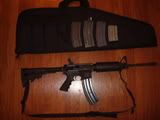Dwell time is the amount of time that there is enough gas pressure at the gas port (either the barrel port, or at the end of the gas tube in the receiver) to operate the action.
That pressure builds, dwells, and then subsides. The greater length of time the curve stays above the amount needed to operate the action, the more reliable the system. Generally longer barrels are better because there is more barrel past the gas port and while the bullet is in the bore (and past the port) it plugs up the expanding gases and the reward is longer Dwell.
Short barrels may mean shorter dwell...notice that 20 and 14.5 have about the same distance from gas port to muzzle. Now, to compensate for that shorter steeper pressure curve, a larger gas port is used. The result is a gas pressure curve that looks more like a pyramid. The spike of the curve may be much higher than needed, and the acceleration of the curve much faster than needed, but you have to have a minimum amount of dwell TIME for the action to function.
OK, so...in shorter barrels this pressure rises very quickly and to levels that can cause damage over time. These excesses are built into the design to ensure functioning in all climates and conditions. Cold really screws with the equations, and to ensure that rifles work well even in very cold climates they are "over gassed" in all other conditions (since you cant change gas port size). Note the 3 gas port settings on the FN-FAL...anywhere, anytime baby.
Ammo will also effect all this...some ammo put more pressure in the system than others. This can be due to bullet weight, velocity, or type of powder used.
Lots of variables. I would hate to be a gun maker trying build AR's that will run all the time with any ammo, in any weather, clean or dirty... So, again we arrive at the most common solution...over gassing.
On all rifles that don't have adjustable gas blocks you cant control gas pressure at the gas port. So you do it at the receiver port.
By using a heavier buffer (I run 9mm's in most of mine) you add inertia to the system. In this case the inertia holds the bolt carrier group closed longer. Instead of allowing the very high pressures to throw the BCG to the rear, the inertial weight of the heavier buffer resists a little longer, lets the pressures subside a bit, and then opens. This is all gentler on the system parts, particularly the bolt lugs (they tend to shear in bad over gas situations since the lugs are still pushed back into the barrel extension by chamber pressure while the bolt is trying to rotate open...check the rear of your lugs for rounded edges to diagnose over gassing).
As I said, the disadvantage to a heavier buffer is that there is more weight going forward on the system as it goes into Battery. But I see this as a good trade off and a benefit to reliability (maybe). The other advantage is that the delayed opening of the BCG means that the rearward velocity of the BCG is lowered and you have less perceived recoil. This is very noticeable.
I love Holiday Inn Express.
PP





